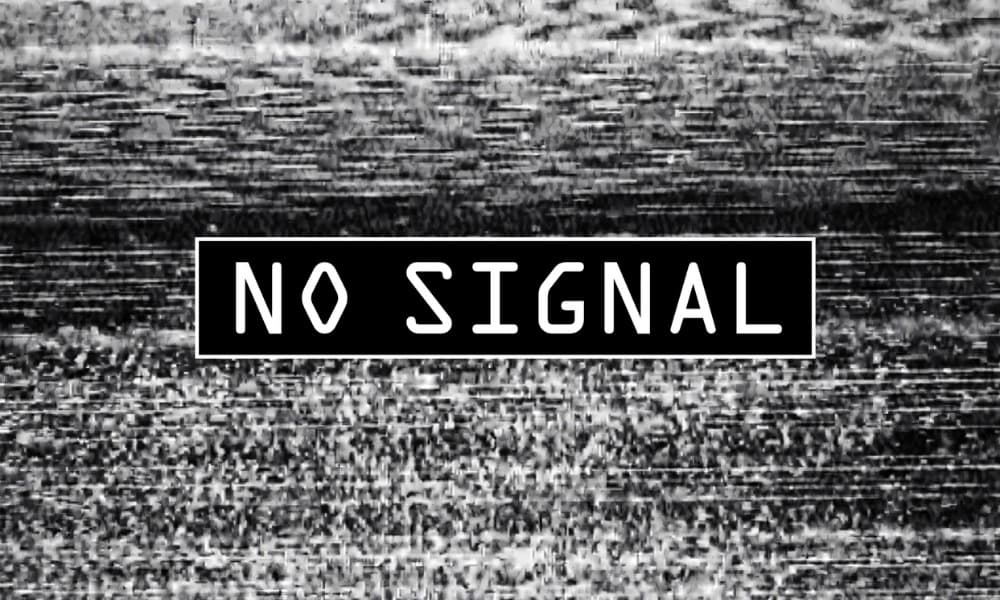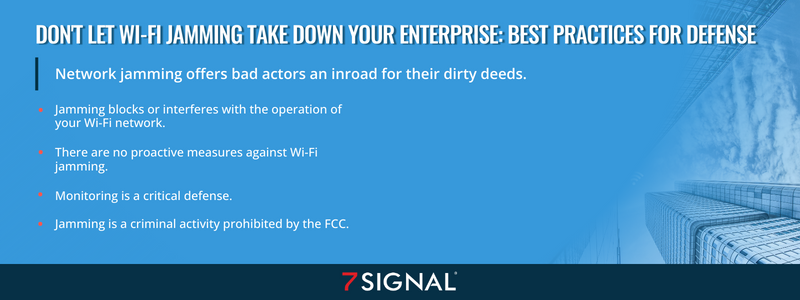
Blog
Network jamming offers bad actors an inroad for their dirty deeds

Wi-Fi jamming is illegal, but bad actors are utilizing this tool to engage in what Lee Badman describes as electronic warfare: denying the “enemy” (your enterprise) the use of the electromagnetic spectrum, something he’s all too familiar with. He spent 10-plus years in the United States Air Force waging the agency’s own form of electronic warfare.
A wireless signal jammer is one thing the WLAN can’t defend itself against. Jamming doesn’t pick and choose technologies – it takes down a frequency range and everything in its path, obliterating the signal-to-noise ratio. The carefully curated signals your Wi-Fi network uses, that perfectly developed modulation, that cutting-edge technology – all laid to waste.
Badman, jamming expert, wireless network architect, CWNE #200, led a Best Practices Webinar Series presentation, Wi-Fi Jamming Discussed, and shared the facts about, and the legal confusion surrounding, Wi-Fi jamming.
What is Wi-Fi jamming?
The Federal Communications Commission (FCC) defines jamming as blocking or interfering with the normal operations of radio communications. These include public safety communications, cellular and other personal communication services, law enforcement radar, and GPS.
Jamming is prohibited
Signal jamming is illegal, as is the advertisement, sale, distribution, importation, and marketing of these devices. If someone is caught using a jammer, they face stiff fines and possible imprisonment. However, the rules are unclear. The narrative of what qualifies as a jammer can be confusing, especially when it comes to Rogue AP Detail, and the option to update status – it offers an option for containment, which is basically jamming the jammer.
Every wireless vendor gives you the option to contain a rogue. You can either launch de-authentication (DEAUTH) frames from nearby access points, or you can let the system decide. The question remains: Is it legal? Since it is essentially jamming, is it prohibited? Perhaps the FCC is being purposely ambiguous, but there appears to be no documentation that rogue containment is authorized, so you proceed at your own risk.
Why jam Wi-Fi?
The reasons people jam Wi-Fi signals vary, although none are legitimate.
- Denial of service (DOS): if a person or an organization wants to prevent using Wi-Fi devices on their network.
- Malicious intent: some use jammers to interfere with a network and cause harm.
- Ignorance of the laws: some may be unaware of the laws that prohibit the use of jammers.
- Larger attack strategy: jamming may be part of a larger attack to gain unauthorized access to a network or data.
Criminals also use jammers to defeat doorbell and security cameras, for example. These devices are not large – about the size of an Apple Watch – and can be easily carried, and are relatively inexpensive. Basically, the jammer’s objective is to cause a user to enter their SSID channel, where trouble awaits.
What does jamming look like?
Jamming is either a wide band or a narrow band. Your Wi-Fi vendor contains carefully crafting usable modulation, but a jammer has more power and a stronger signal.
.png?width=1160&height=622&name=image3%20(10).png)
Wide-band jamming uses a more powerful, wider signal than your Wi-Fi and operates with brute force, purposely holding a large swath of the spectrum.
.png?width=854&height=424&name=image2%20(10).png)
Narrow-band jamming hits a single channel. This is likely because the jammer wants you to move to another channel where they have something malicious waiting.
In both cases, jamming is generally higher powered, using much more than the typical 100 milliwatts, and often measuring in complete watts. Jamming is meant to be devastating.
How is jamming used in more complex attacks?
In more complex attacks, criminals can serve up a DOS to jam your wireless security cameras so they can burglarize undetected. They can target the jamming to bump you off your channel to make you use another channel where, instead of what you’re looking for, a place where jammers can perform nefarious deeds. They also can perform DEUTH jamming with a different device to move you off your network to one that will present serious issues for you.
How is jamming detected?
You can’t detect jamming on your own. You need an enterprise Wi-Fi expert with specialized equipment; even then, finding the jam can be difficult. Here are a few things to consider:
- Identifying jamming requires a spectrum analyzer, and even then, it may be hard to distinguish jamming from another product’s radio signal.
- Detecting jamming needs a monitoring system that can classify and report jammers.
- Recognizing jamming without Wi-Fi tools can be challenging because jamming is rough to distinguish from a high-noise floor.
Finding the jamming may require a “fox hunt” when a handheld spectrum analyzer or another Wi-Fi tool that shows spectrum is used to pin down the noise floor. This method takes a great deal of creativity and skill.
Protect your network against Wi-Fi jamming
Wi-Fi jamming is a serious threat to network security. Monitoring your network is a critical defense against this threat. However, detecting and identifying jamming requires specialized equipment and expertise. By staying aware of this threat and taking the necessary precautions, you can keep your network secure and prevent bad actors from using jamming as an inroad for their dirty deeds.
Suspect jamming? 7SIGNAL has your back
7SIGNAL is the leader in Wi-Fi Wi-Fi optimization, and its monitoring tools can help find the jam fast and ensure you end up in a safe place. Founded by wireless networking pioneers, 7SIGNAL delivers applications that continuously monitor the stability of our clients' Wi-Fi networks to mitigate risk. Contact 7SIGNAL today.
The 7SIGNAL platform is designed for the world's most innovative organizations, educational institutions, hospitals, and government agencies and is currently deployed at IBM, Kaiser Permanente, Nike, and other Fortune 500 companies. 7SIGNAL continuously monitors the connectivity of an estimated 20 million global devices. Learn more at www.7signal.com.